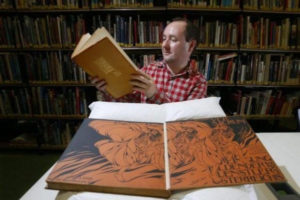Duncan Chappell, Glasgow School of Art
Category: Blog, Meet our Members
This blog is part of our Meet our Members series, focusing on different members and their careers.
 My name is Duncan Chappell and I have worked as a librarian at Glasgow School of Art since 2006. When I took up post, my job title was Subject Librarian for the School of Fine Art but in common with many HE libraries, we have moved to a more generalist model, sharing our skills with all departments and faculties. My current job title is therefore Academic Liaison Librarian and I am responsible, with my colleagues, for liaison with academics, teaching for skills development, and collection management.
My name is Duncan Chappell and I have worked as a librarian at Glasgow School of Art since 2006. When I took up post, my job title was Subject Librarian for the School of Fine Art but in common with many HE libraries, we have moved to a more generalist model, sharing our skills with all departments and faculties. My current job title is therefore Academic Liaison Librarian and I am responsible, with my colleagues, for liaison with academics, teaching for skills development, and collection management.
We are a small team, so inevitably we all get involved in many aspects of the life of the institution. We are often asked to lend our skills to projects elsewhere, and this makes my working life very varied and dynamic. In larger institutions, we would probably be more constrained by institutional structures, but at GSA we have a lot of latitude to reach out to other departments and work alongside them to deliver services of real benefit to students. In total, we have around 2000 students working across the disciplines of art, design and architecture, and end up knowing most of them by name by the end of their time with us. We are small and close community, and much less anonymous than some other universities.
I work with undergraduates, taught postgraduates, and research students, and each student comes with their own particular needs and requirements. Most of our students however do not come from a conventionally ‘academic’ background – they come to us to paint, sculpt or design, rather than theorise. This means that many struggle a little with the kinds of academic skills that might be taken as read elsewhere. When working with students, I always try to keep in mind that they are makers, rather than scholars. Most work as independent creative practitioners, including our academics who would typically combine their own practice with a few hours of teaching a week.
To work in an environment like GSA, you have to be very flexible and personable. A small institution will not always have the infrastructures of larger institutions, and money is inevitably hard-fought. This provides a lot of opportunity to experiment and be creative in our thinking. I am given a lot of freedom to initiate projects or try out new techniques. If we want to try something out, we just go for it, and see what happens! Building and maintaining personal relationships is also key, so the role would not suit people who like to keep to themselves.
A typical day might begin with the delivery of a workshop to our portfolio preparation students, before attending a meeting of programme leaders for Fine Art Critical Studies. Here I would check that they are feeling supported by the library, and whether they are encountering any issues. I might also brief them on the roll-out of a new reading list system we will be embedding this year. In between, I will need to respond to any enquiries that I have received from students, staff or externals, or check in with the staff I manage. In the afternoon I may do some work to digitise our historical collections, or work on improving our metadata to ease resource discovery. Our total print collection is around 60,000 volumes, but our electronic collections are increasing exponentially. Because of the learning styles, our students do tend to like material objects and many are not as comfortable with digital resources as might be supposed. Nevertheless, our electronic content provides a useful complement to our high-demand print collections. A lot of people might suppose that working in an art library is less technology-focused than some other sectors, but this is a false assumption. In fact, you will probably find yourself more involved in systems and platforms, as there are so few other people to call upon. You really do have confidence in all areas of information work.
My first job in a library was at the London School of Economics, which I joined soon after finishing an undergraduate degree in History of Art. From there I moved to the library at the National Portrait Gallery, before relocating to Glasgow for my postgraduate degree in Information Science. I then had stints as a Digitisation Manager at a charity and Librarian at an FE college, before joining GSA in 2006. I have therefore worked in the HE, FE, special, and third sectors and am pretty sure that this breadth helped me gain my current position. Since joining GSA I have gained a further masters degree in Education – librarians in HE are increasingly expected to have some form of qualification in learning and teaching, as this forms such a central part of our role.
As someone working in a smaller institution, I have always found that my CILIP membership exposes me to all kinds of developments that I can learn from and perhaps adapt for our own learners. I have been mentoring Chartership candidates for the last few years, and learn a lot from their experiences. I also sit on the committee of the ARLG Scotland special interest group, as well as several other working groups or communities of practice. These arenas help me to broaden my knowledge, and stop me becoming stale!